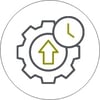Table of Contents
In today's data-driven healthcare landscape, organizations are inundated with information from countless sources. The challenge lies not in collecting data, but in identifying which metrics truly matter and leveraging them to improve clinical and operational outcomes. Leading healthcare executives recently shared their insights on how to optimize processes using meaningful data.
Starting Broad, Narrowing Focus
Dr. Vinay Vaidya, Chief Medical Information Officer at Phoenix Children’s Hospital, advocates for a broad initial approach to data collection. “We are data hogs,” he explains. “You come within one mile of Phoenix Children’s, and if you’re identified, data will suck it in.” This comprehensive data gathering allows organizations to capture potentially valuable information they may not have initially considered important.
However, the key is then narrowing that focus to actionable insights. Vaidya uses the analogy of a kitchen: “It’s no different than your kitchen pantry. Anything, we just throw things in. And then what do you want to cook? Is it gumbo or a steak? And then pick what data you want.”
This approach allows healthcare systems to maintain flexibility while still prioritizing the most impactful data points for their specific goals and challenges.
Balancing Quality, Quantity, and Speed
When it comes to data analytics, healthcare leaders must balance three critical factors:

Quality

Quantity

Speed
While data accuracy is crucial, Vaidya argues that speed often takes precedence. "You can give quality, you can give quantity, and if I give it to my physician six months later, the problem has gone, the interest has gone," he notes.
Start with quantity and refine for quality over time, while prioritizing rapid delivery of insights. This approach allows organizations to provide timely, actionable information to clinicians and administrators, even as they work to improve data accuracy and depth.
Kristen Dubesky, Vice President of Data at Penn Medicine, echoes this sentiment, emphasizing the importance of real-time data for patient safety and clinical decision-making. "We focus a lot on the real-time data in order to make good real-time interventions," she explains.

From Data to Action
Collecting and analyzing data is only the first step. The true challenge lies in translating insights into meaningful action. Dr. Tarun Kapoor, Chief Digital Transformation Officer at Virtua Health, stresses the importance of focusing on opportunities rather than getting lost in the data itself.
"Everyone's like, wow, look at all this data we have. And a lot of it comes out to be so what?" Kapoor observes. He advocates for a more targeted approach: "What is my opportunity that I think I can impact? And as the saying goes, just because you can doesn't mean you should."
This opportunity-focused mindset helps healthcare organizations avoid pursuing data projects that, while interesting, may not lead to tangible improvements in patient care or operational efficiency.
Prioritizing Data Projects
With limited resources and countless potential data initiatives, healthcare systems must carefully prioritize their efforts. Vaidya shares a framework used at Phoenix Children's called "SQUARES":

Safety

Quality

Access

Regulatory compliance

Efficiency

Financial impact
This framework helps guide decision-making around data projects, ensuring that initiatives align with organizational priorities and have the potential for meaningful impact.
Leveraging Patient-Generated Data
As wearable devices and home health monitoring tools become more prevalent, healthcare organizations are exploring ways to incorporate patient-generated data into their processes. However, leaders caution against overcomplicating these efforts.
Vaidya shares an example of a successful patient-reported outcome program for infants with cleft lip and palate. By focusing on simple, targeted questions and basic weight measurements, the program reduced malnutrition by 25% and decreased unnecessary clinic visits by 30%.
"You don't need to have super fancy, don't have to have armpit sweat monitor to diagnose anxiety," Vaidya notes. "You can get really valuable information that you are not getting for three months because that's the visit interval."

The Role of Artificial Intelligence
While artificial intelligence (AI) generates significant buzz in healthcare, the panelists advocate for a measured approach. Kapoor emphasizes the importance of understanding different types of AI and their appropriate applications:
"When we say AI, I start asking a question, what do you mean by AI? Because a lot of times people are talking about automations, and they are not AI."
He distinguishes between:
- Automation: Humans write the rules, machines execute them
- Traditional AI/Machine Learning: Machines can write or rewrite rules based on data
- Generative AI: More advanced systems that can produce variable outputs
The executives agree that AI projects should be carefully evaluated based on organizational priorities and potential impact, rather than pursued simply for the sake of innovation.
Overcoming Barriers to Data-Driven Change
Implementing data-driven processes often faces resistance, particularly from clinicians. Kapoor attributes much of this resistance to fear, stemming from past experiences and ingrained practices. He recommends a gradual approach to change management:
"Let's do one together, and let's show that it worked. And then let's do another one and show that it worked."
By demonstrating success and addressing concerns directly, healthcare leaders can build trust in new data-driven processes.
Vaidya adds that making data "excruciatingly transparent" can drive adoption. At Phoenix Children's, most dashboards are accessible to anyone with EMR access, and usage is tracked. This transparency creates accountability and encourages engagement with data tools.
As healthcare organizations continue to refine their data strategies, the panelists emphasize that the ultimate goal must be actionable change. Dubesky concludes:
"If you're not going to do anything differently, there's no point in doing any of this. And so that's what we challenge individuals all the time when they have a new project that comes up or they have this idea. We say, great, what are you going to do next?"
By focusing on meaningful metrics, prioritizing speed and action, and carefully evaluating new technologies, healthcare leaders can harness the power of data to drive real improvements in patient care and operational efficiency. The key lies not in collecting more data, but in asking the right questions and committing to data-driven change.

 By
By 

